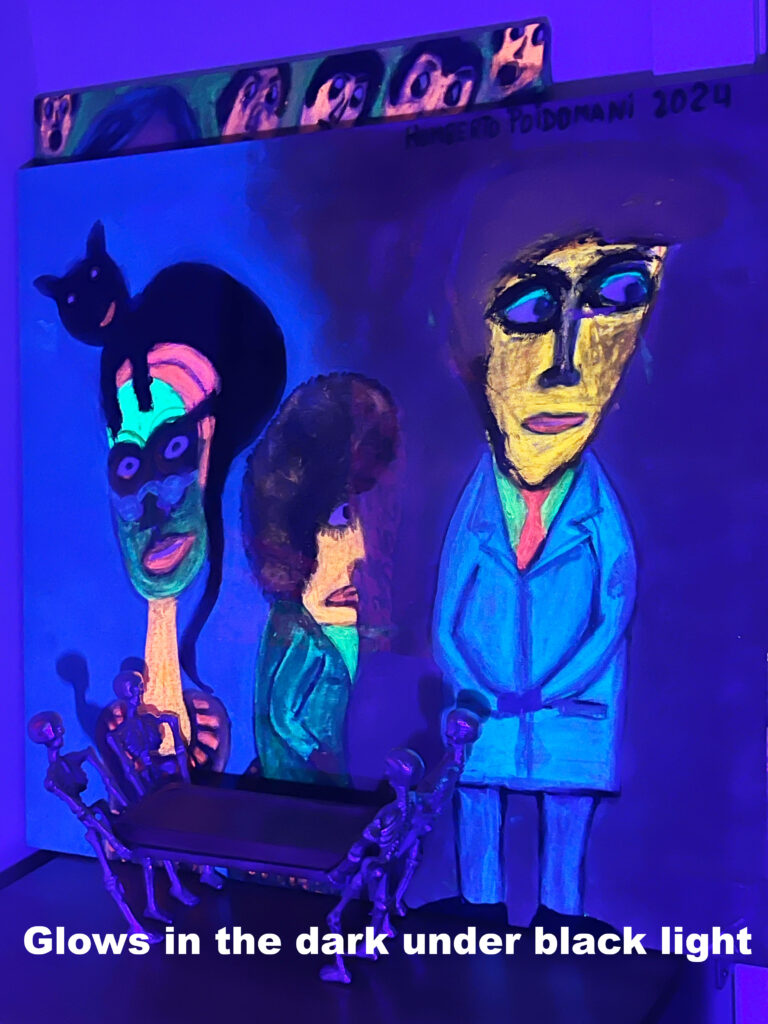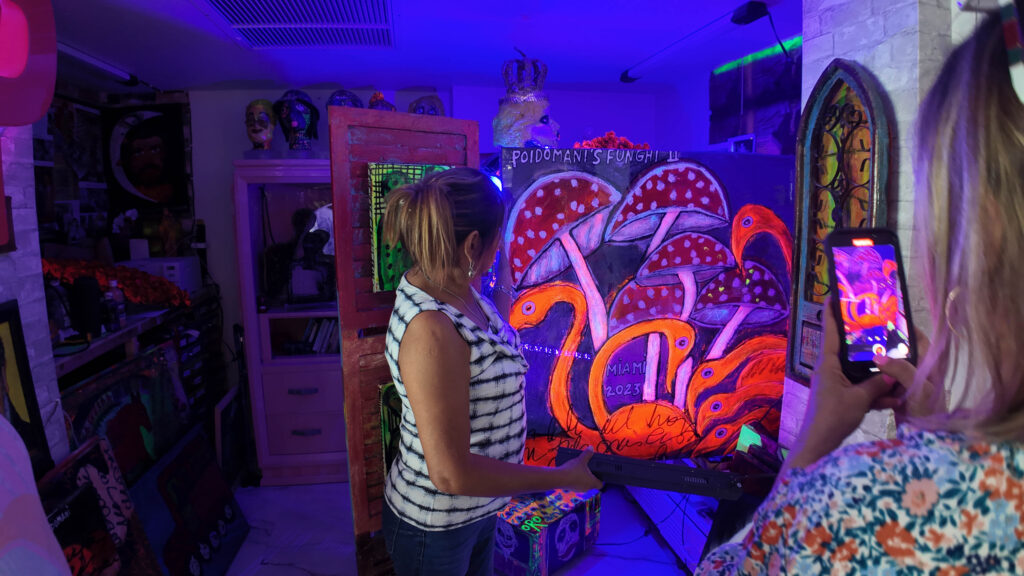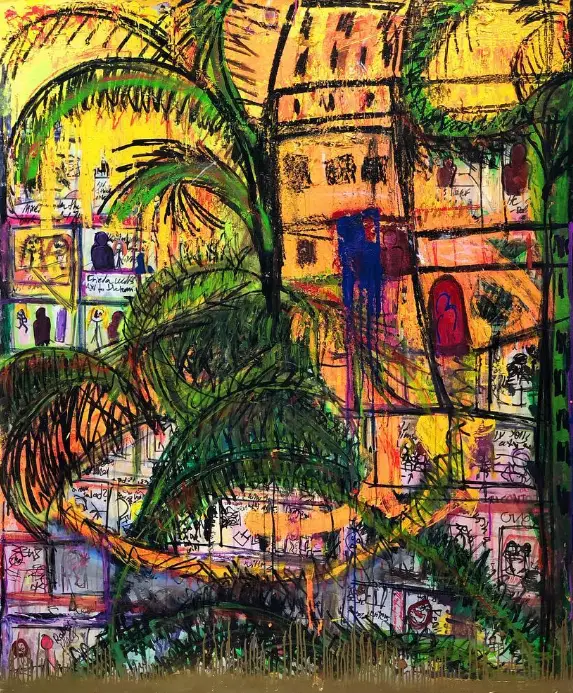黑光藝術是一種融合藝術與科學的迷人流派,持續吸引當代藝術愛好者、藝術收藏家和室內設計師等。使用紫外線(紫外線)光線揭示隱藏的螢光塗料層,黑光藝術創造出令人著迷的效果,可以改變現代和當代空間。無論是繪畫的充滿活力的光芒還是光與影之間的動態相互作用,這種藝術形式為藝術收藏家和當代藝術家探索提供了獨特的可能性。
隨著對創新和沈浸式藝術的需求不斷增長,黑光藝術提供了美學吸引力和令人信服的藝術投資機會,特別是像Humberto Poidomani 這樣的阿根廷當代藝術家,他們利用這種媒介傳達更深的意識形態和社會資訊。在本文中,我們將深入探討黑光藝術的科學、歷史和潛在應用,展示它如何裝飾現代空間,同時也成為藝術收藏家的寶貴資產。
了解黑光藝術和螢光燈
黑光藝術的核心是利用紫外線 (UV) 輻射來照亮某些含有螢光顏料的材料。黑光通常在 UV-A 光譜(320-400 nm)下工作,發出人眼看不見的紫色光芒,但會導致螢光材料發出可見光。這種反應造成了黑光藝術的核心發光效果。
螢光顏料,例如專門設計的丙烯酸塗料中的螢光顏料,吸收紫外線並將其重新發射為可見光。這些顏料通常含有鋅 硫化物 或硫化鎘, 化學品 創造出許多黑光裝置中常見的發光效果。當黑光照射到藝術品上的螢光塗料時,某些區域會“彈出”,與非螢光區域形成鮮明對比。
雖然黑光藝術起源於 20 世紀 60 年代的迷幻藝術運動,但它已發展成為當代藝術家嘗試光、色彩和紋理的動態工具。
黑光藝術的歷史背景:從迷幻到當代
黑光藝術在 20 世紀中葉廣泛流行,尤其是在迷幻藝術運動期間,藝術家們尋求創造令人費解、視覺刺激的體驗。這是一段實驗時期,紫外線裝置照亮了充滿活力的壁畫和塗鴉,賦予藝術品超現實、近乎夢幻的品質。迷幻街頭藝術和大型壁畫開始 合併 黑光元素,進一步突破了視覺藝術所能達到的界限。
快轉至 今天, 當代藝術家繼續探索黑光藝術的潛力,將其用於畫廊、裝置,甚至私人收藏。當代藝術家,例如來自阿根廷的藝術家,正在將這種技術融入他們的作品中,使這種媒介超越其迷幻的根源,並將其牢固地融入他們的作品中。 的領域 現代藝術。
其中一位藝術家是 Humberto Poidomani是一位來自阿根廷的著名當代藝術家,以其對現成材料和意識形態主題的創新運用而聞名。波伊多馬尼的作品經常深入探討社會危機、衰敗和環境退化等主題。將黑光元素融入他的雕塑和裝置中,增加了另一層深度,強調了現代生活隱藏或被遺忘的面向。波伊多馬尼的作品是黑光藝術如何提升當代裝置藝術,在視覺和智力上吸引觀眾的絕佳範例。
黑光藝術如何點綴當代空間
對於室內設計師來說,黑光藝術提供了一種大膽而創新的方式來裝飾現代和當代空間。黑光下的發光和變化的色調為任何房間增添了活力,無論是時尚簡約的辦公室還是充滿活力的客廳。
透過將黑光繪畫或裝置放置在原本中性的空間中,設計師可以創造出引人注目的對比,吸引註意力並在房間內形成焦點。這些藝術作品與標準照明和紫外線照明相互作用,為觀眾創造了雙重體驗。例如,白天,黑光畫可能會顯示為標準的壓克力藝術品,但是當 夜幕降臨 和 打開紫外線燈,螢光顏料就會活躍起來,將藝術品變成發光、空靈的中心裝飾。
這種二元性使得黑光藝術具有多種用途 廣泛的 從私密的住宅空間到大型商業設施。在美術館和公共展覽中,黑光藝術經常被用來創造身臨其境的環境,挑戰觀眾的感知,邀請他們以視覺和情感的方式與藝術品互動。
當代藝術中的美感與意識形態運用
黑光藝術不僅增加了視覺吸引力;它還可以傳達更深層的象徵意義。像 Humberto Poidomani 這樣的藝術家使用黑光來強調所見與隱藏之間的對比,就像社會問題經常隱藏在表面之下一樣。在波伊多馬尼的作品中,發光的紫外線元素可能像徵著社會的衰落或環境的忽視。同時,黑暗的、未觸及的區域代表著看不見但緊迫的問題。
對當代藝術家來說,黑光藝術提供了一種獨特的媒介來傳達意識形態的緊張關係。螢光顏料的發光可以 習慣 代表生命的脆弱、人類存在的短暫性,或繁榮與貧窮之間的鮮明對比。當黑光揭示了藝術品的「隱藏」面向時,它邀請觀眾思考社會中可能隱藏的其他東西。
藝術投資與黑光藝術
隨著藝術界越來越擁抱互動和多媒體作品,黑光藝術為 藝術收藏家 和 art 投資者。這種藝術形式的新穎性,加上其技術和美學的複雜性,可以增加作品的價值,尤其是由像波伊多馬尼這樣以突破藝術界限而聞名的著名藝術家創作的作品。
投資黑光藝術需要考慮視覺衝擊力及其長期保存。紫外線雖然對於顯示螢光元素至關重要,但隨著時間的推移會降解某些顏料和材料。這對藝術家和收藏家在保護方面都提出了挑戰。為了保持藝術品的價值,收藏家必須確保藝術品在受控的照明條件下展示,並防止長時間的紫外線照射。保護和保存紫外線敏感材料可確保藝術投資對當今的視覺享受和未來的財務安全保持良好的狀態。
對於尋求投資組合多元化的投資者來說,購買當代藝術家(尤其是來自阿根廷等地區的新興藝術家)的黑光藝術作品提供了一個獨特的機會。像波伊多馬尼這樣獲得國際認可的藝術家,他們的作品會隨著時間的推移而升值,這使他們成為經驗豐富的藝術投資者和市場新手的可靠選擇。
展覽和公共空間的黑光
博物館和畫廊越來越多地將黑光藝術融入他們的展覽中,並用它來創造多維、身臨其境的體驗。當選定的作品在紫外線下展示時,觀眾可以以不同的方式與藝術品互動,增強他們的情感反應並鼓勵更深入的互動。黑光元素使藝術品充滿活力,增加了僅在特定照明條件下可見的層次。
黑光藝術可以在公共藝術裝置中營造出奇妙和好奇的感覺。例如,使用紫外線響應顏料的城市壁畫在夜間變得栩栩如生,將原本靜態的作品轉變為與周圍環境互動的發光展示。在大型戶外裝置中,黑光可以突出特定的建築元素或增強自然光與藝術品之間的相互作用,創造一種運動和流動感。
保護和保存問題
雖然黑光藝術的視覺效果令人驚嘆,但它們也伴隨著 肯定 保護挑戰。隨著時間的推移,紫外線會降解材料,特別是有機顏料。對於藝術家和收藏家來說,這意味著找到方法來保護作品免受過度紫外線照射,同時 仍然允許 互動元素大放異彩。
對於藝術收藏家和投資者來說,這涉及確保藝術品在直接紫外線照射最少的環境中儲存和展示。在框架中使用紫外線過濾玻璃或丙烯酸樹脂並避免過度使用紫外線將有助於延長黑光藝術品的使用壽命,確保它們多年來仍然是有價值的投資。
结论
總之,黑光藝術獨特地增強了當代空間,彌合了科學、藝術和意識形態之間的差距。對於室內設計師和當代藝術愛好者來說,將黑光作品融入現代空間可以創造動態、身臨其境的體驗,將平凡變成非凡。為了 藝術家, 例如阿根廷的Humberto Poidomani,黑光藝術作為傳達訊息的工具 更深 社會訊息,同時 藝術收藏家 和 投資者,這些作品為美感欣賞和 藝術品投資.
憑藉其大膽的視覺衝擊力和象徵深度,黑光藝術將繼續吸引觀眾並突破當代藝術的界限。無論是在私人收藏、公共空間或商業畫廊中展示,這種藝術類型都為現代世界的藝術表達和投資開闢了新的可能性。
2024 年及以後的藝術趨勢:黑光藝術在未來的作用
當我們展望 2024 年藝術趨勢黑光藝術正在成為沉浸式和互動藝術領域的關鍵參與者。憑藉其迷人的螢光顏料和紫外線的融合,這種類型滿足了人們對藝術不斷增長的需求,藝術不僅裝飾空間,而且將其轉變為引人入勝的體驗。 2025 年藝術趨勢 將進一步突破基於光的裝置的界限,在美術館和私人收藏中使用黑光將因其獨特的能力來揭示藝術作品中隱藏的層次和意義而變得越來越受歡迎。





